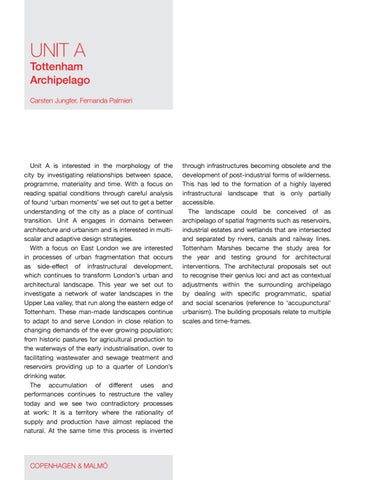UNIT A
Tottenham Archipelago Carsten Jungfer, Fernanda Palmieri
Unit A is interested in the morphology of the city by investigating relationships between space, programme, materiality and time. With a focus on reading spatial conditions through careful analysis of found ‘urban moments’ we set out to get a better understanding of the city as a place of continual transition. Unit A engages in domains between architecture and urbanism and is interested in multiscalar and adaptive design strategies. With a focus on East London we are interested in processes of urban fragmentation that occurs as side-effect of infrastructural development, which continues to transform London’s urban and architectural landscape. This year we set out to investigate a network of water landscapes in the Upper Lea valley, that run along the eastern edge of Tottenham. These man-made landscapes continue to adapt to and serve London in close relation to changing demands of the ever growing population; from historic pastures for agricultural production to the waterways of the early industrialisation, over to facilitating wastewater and sewage treatment and reservoirs providing up to a quarter of London’s drinking water. The accumulation of different uses and performances continues to restructure the valley today and we see two contradictory processes at work: It is a territory where the rationality of supply and production have almost replaced the natural. At the same time this process is inverted
COPENHAGEN & MALMÖ
through infrastructures becoming obsolete and the development of post-industrial forms of wilderness. This has led to the formation of a highly layered infrastructural landscape that is only partially accessible. The landscape could be conceived of as archipelago of spatial fragments such as reservoirs, industrial estates and wetlands that are intersected and separated by rivers, canals and railway lines. Tottenham Marshes became the study area for the year and testing ground for architectural interventions. The architectural proposals set out to recognise their genius loci and act as contextual adjustments within the surrounding archipelago by dealing with specific programmatic, spatial and social scenarios (reference to ‘accupunctural’ urbanism). The building proposals relate to multiple scales and time-frames.
